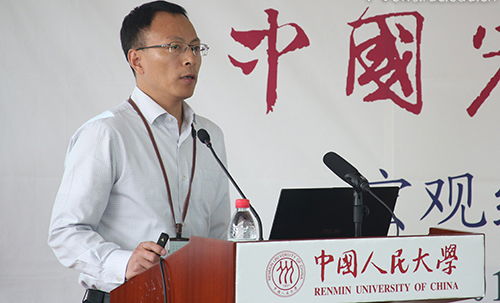Q1 data shows signs of rebound

At a forum on April 19 in Beijing, Yu Chunhai, a professor of economics from Renmin University, analyzes highlights of the economic performance in the first three months and pointed out imbalances that may occur.
At a recent forum, scholars said the 6.9 percent growth rate seen in the first three months exceeded expectations and shows the year is off to a good start. The data prompted the International Monetary Fund to revise China’s growth projections for the entire year from 6.5 percent to 6.6 percent in the recently released World Economic Outlook.
China’s GDP reached more than 18 trillion yuan in the first quarter of 2017, growing 6.9 percent year-on-year, the National Bureau of Statistics announced on April 17. The growth rate was up 0.2 percentage points compared to the same period last year and up 0.1 percentage point from the fourth quarter of last year.
Scholars analyzed the data in the first quarter at a forum co-hosted by the National Academy of Development and Strategy, and the School of Economics at Renmin University of China as well as China Chengxin Credit Management Company on April 19 in Beijing.
Yu Chunhai, a professor of economics from Renmin University, analyzed the report at the meeting. According to the report, the national economy showed strong momentum in the first quarter. It showed signs of rebound after hitting the bottom in terms of various indicators, such as GDP growth rate, supply and demand, industrial profits, price index and Business Climate Index.
In addition to the overall trends of stability and momentum, Yu pointed out other highlights of economic performance in the period. The economic structure continued to improve, with the service industry, high-end manufacturing and consumption accounting for a greater share of GDP growth. Investment in fixed assets continued to grow driven by infrastructure construction and private investment.
Yu said the improvement in global demand has reversed the decline in China’s foreign trade and that a slower decline in foreign exchange reserves dampened the impact of economic downturn. Rising prices have eased economic deflation while increasing profits have encouraged the differentiation of industrial enterprises and the Business Climate Index continues to rise within the range of expansion, he added.
However, Yu also warned that imbalances may occur. If fixed investment grows at a faster rate than consumption, it could result in an unbalanced demand structure. Export expansion based on the previous product mix may obstruct any adjustment to the domestic structure. A continued service trade deficit may harm current accounts, posing a threat to the domestic service industry. If there is an accompanying change in the structure of China’s external financial assets with the decrease in foreign exchange reserves, the private sector may be exposed to the impact of international financial crisis, Yu said.
Liu Yuanchun, vice-president of Renmin University, emphasized a greater role for the “Belt and Road” initiative in boosting China’s exports. Other nations along the routes of the “Belt and Road” accounted for 28 percent of China’s exports, a slight growth from 25 percent in 2013, when the initiative was proposed.
The proportion of other nations along the routes—excluding ASEAN countries—in China’s exports has remained almost unchanged, Liu added. He attributed the growth of China’s exports to ASEAN countries to deepened economic and trade cooperation between the two sides with the establishment of the China-ASEAN Free Trade Area. It is necessary to further tap the potential of the initiative in driving China’s export growth, he added.
ZHANG JUNRONG, LÜ MENGDI are reporters at the Chinese Social Sciences Today.

 PRINT
PRINT CLOSE
CLOSE